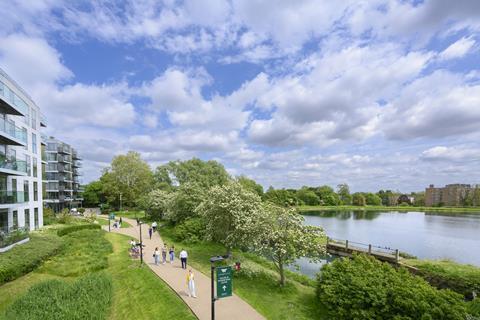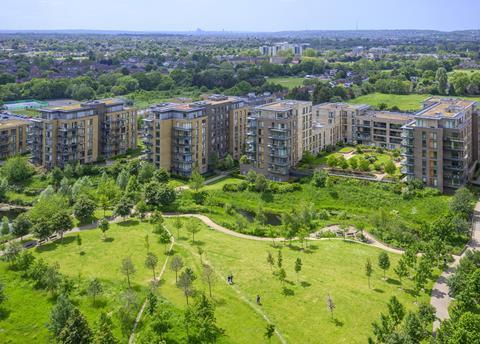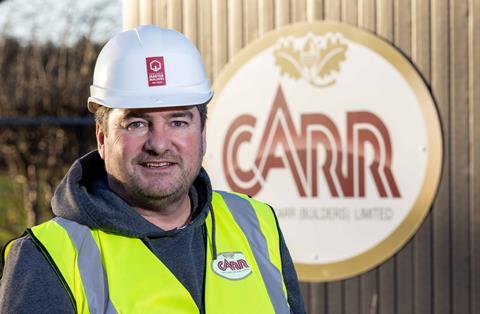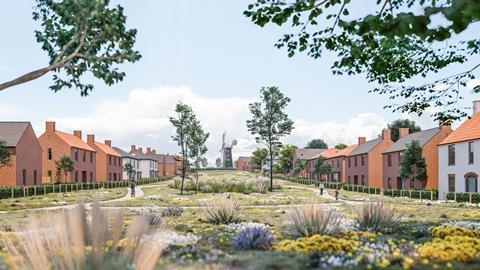From this month, all developments will have to show how they increase biodiversity by 10% in order to receive planning permission. Joey Gardiner looks at whether the policy is a win-win or too much too soon

Almost six years after Michael Gove as environment secretary first promised to make protecting the natural world go “hand in hand” with building more homes, the government’s compulsory biodiversity net gain policy will finally be introduced later this month. Under this policy, all development projects will have to ensure that they generate an increase of at least a 10% in biodiversity, either on site or by off-setting.
At the time, Gove said that his biodiversity net gain (BNG) plan, which became enshrined in the 2021 Environment Act, put “the environment at the heart of planning and development”. Now as housing secretary, overseeing its roll-out across the sector, he says it will ensure that developers “enrich local wildlife when delivering new homes and infrastructure”.
Either way, it is hard to underplay its significance to the industry, potentially fundamentally affecting how developers design, landscape, value, manage and market their sites, and adding a big new layer of complexity into the planning process at a time when the system is already buckling under the strain of a resourcing crisis. “It’s something that’s had a fundamental effect on the way we approach sites,” says Neil Beamsley, group head of biodiversity at listed builder Bellway.
While the final details of the mandatory scheme have only just emerged, the biggest developers have largely been able to skill up, look ahead and do their best to adopt BNG ahead of the game. But huge questions remain over how it will work in practice, and the readiness of smaller developers and local authorities for its introduction. So, what will it mean for the sector?
“Hugely positive”
The principle of BNG is straightforward – to leave a site with better biodiversity after a development than before. Some local authorities have had policies requiring biodiversity net gain – or at least no net loss – for a few years, and some developers that have experience of that, and have positively adopted net-gain strategies, have said it can produce benefits at little cost.
Listed London-based giant Berkeley Group, for example, an early adopter of BNG which claims to have delivered net gain on 54 projects, says it successfully uses images of its biodiverse landscaping in the front and centre of its marketing efforts to drive buyer interest. Louise Clarke, group head of sustainability for Berkeley, says: “As long as you think about biodiversity early in the process, it shouldn’t really cost you more – you need to think of it as part of your design and landscaping. And, in planning terms, offering net gain is seen as hugely positive.”
Developers like Berkeley and Bellway, with the resource to employ in-house specialists and ecologists, have developed processes to ensure net gain is considered even at the point of buying land. Beamsley says he signs off on the net gain assessments made on behalf of Bellway’s land teams before purchase or option agreements are signed, to ensure that no offsite credits will be required.
Case study: Berkeley Group – Kidbrooke

Berkeley Group decided to make its 4,800-home Kidbrooke Estate regeneration project a trial run for its then new biodiversity strategy in 2017, while already 1,000 homes into to the build programme.
Louise Clarke, group head of sustainability at Berkeley, says this meant enhancing much of the existing landscaping designs that had been delivered as part of new Cator Park built in the first phase by adding more plantings and replacing water features with wetlands, in consultation with the London Wildlife Trust. This has required them changing the way they procure landscaping she says, because of the need to be much more exact about plant species, in order to deliver the correct habitats to encourage animal life.
Clarke says Berkeley had to “engage” with local people in order to ensure they were on-side with how the biodiverse landscaping would look across the seasons. “It’s a lot more natural landscape. Spring and summer it looks great, but autumn and winter it won’t look so nice.
Despite this, people see the benefit, she says. “You just have to explain it, and then they love it.”
The developer claims to have delivered 98% net gain over the landscape existing when its improvements started – albeit not prior to the entire redevelopment in 2008, as that wasn’t thought of back then. Since Kidbrooke, Berkeley has gone on to plan or deliver biodiversity net gain across 54 developments, and claims projects in train to create 550 acres of improved habitats, including 235 acres of woodland, 150 acres of grasslands and 55 acres of living roofs.
While Clarke says she has in one instance had to buy a separate adjacent site on which to deliver BNG improvements, “generally you can do net gain on the development itself. As long as you think early it shouldn’t cost you more.”
Rachel Danemann, who as a planning manager at the Home Builders Federation (HBF) has been leading on the BNG policy for the trade body, says the “bigger builders” are “fairly comfortable with BNG”.
Clearly, therefore, there is the potential for Gove’s vaunted win-win here, as net gain done properly could make a substantial difference to habitat loss. Ben Kite, MD of environmental consultancy EPR, which works with local authorities, landowners and developers, says there is a prospect for it to be a vehicle through which councils can fund improvements they want to make in the environment, if they do work up front to identify and allocate strategically located sites for habitat banks in local plans and local nature recovery strategies.
“I’m in favour of trying to deliver biodiversity on site,” he says. “But, where you can’t, the opportunity is to make councils’ nature recovery strategies, which otherwise might sit on a shelf, something that developers can fund when they buy BNG credits.”
Too much too soon
But, as Kite’s comment indicates, the straightforward desired outcome of improving biodiversity belies huge complexity in the detail of the scheme design (see: How will BNG work). And it is that complexity, rather than the principle of it, which is causing some major concerns.
Chris Carr, MD of Cleethorpes-based SME developer Carr & Carr Builders and national president of the Federation of Master Builders, says the reams of regulation combined with a lack of preparedness at local authorities mean that it will be impossible for smaller firms to manage. “It’s too much, too soon and it’s too complex,” he says.
The HBF’s Danemann says that, while some firms are undoubtedly getting totally behind net gain, “some fear it could still become a nightmare. We need to ensure the guidance and local authority resource are in place.”
>> See also Local authorities plan to increase biodiversity net gain by more than 10%
>> See also Housing developers must not leave it too late on Biodiversity Net Gain
>> See also Biodiversity rules risk a delivery slowdown but there are opportunities too
Rico Wojtulewicz, head of policy at the House Builders Association (HBA), an offshoot of the National Federation of Builders which represents SME developers, says his organisation was an early supporter of net gain when it was first discussed over a decade ago – on the basis that it was brought forward in a way that small firms could cope with. But he says this has proved to be anything but the case.
An HBA policy document he produced last year said: “Our only caution throughout the process was that it did not turn into an offsite tax harming SMEs […] Unfortunately, our worst fears have been realised.”
Wojtulewicz adds: “It’s the only time I feel guilty for the work I’ve done for my members. We tried to do the right thing, but BNG has been developed in a way that’s completely perverse, and our members are going to be really badly hit.”
Sites of fewer than 10 units will at least benefit from a delayed introduction to the scheme – to April 24 – and be able to use a simplified metric, but Wojtulewicz says this will not be a significant assistance, helping only the very smallest firms.
Prohibitive
For SMEs, concerns remain over viability and deliverability. Despite Clarke’s assertion that delivering net gain need not cost much, the testimony emerging from experience is that costs are wildly variable, and particularly dependent upon whether net gain can be generated on site or not.
Bellway’s Beamsley says the cost impact is very variable “on a case by case basis”, and that while “a significant proportion” are within viability, there are a minority of sites where costs can be “more prohibitive”.
He adds: “It’s only going to be a small number of cases. But most challenging are going to be small sites that have a decent existing biodiversity value, where you’ll inevitably lose a lot in the development. With bigger sites, you have more luxury in getting that back.”
Box: How will BNG work?
The BNG system proposed uses the creation of habitats as a proxy measure for biodiversity, in order that developers do not have to spend time undertaking bat and beetle counts. A metric for measuring habitats held by Defra effectively rates different habitats for their biodiversity value.
Developers must employ ecologists to undertake baseline assessments of sites using the metric and then work up their plans in order that the resulting scheme delivers an overall score 10% higher than the initial baseline, with the improvements guaranteed for 30 years. According to draft planning practice guidance, the details of how any applicant plans to meet the mandate will need to be set out in a biodiversity gain plan, submitted to a local authority only after an application has been approved.
The system contains a strong presumption that biodiversity enhancements should be delivered on-site where possible, however there is also an acceptance that this will not always be possible, particularly on tighter urban sites. In these cases, developers are to be allowed to offset their biodiversity requirements by buying biodiversity units (BDUs) from third parties – effectively landowners who have set aside land to be used as habitat banks. The government has set up a national habitat bank as a back-stop last resort option for developers that are unable to find third-party suppliers of credits.
The government has said the system will come into force in January, but it has not yet set an exact commencement date.
Nuala Wheatley, senior planner at planning consultant Lichfields, says: “Cost impacts will depend on a case-by-case basis on the value of habitat existing on a site, and the space within the site.” On some sites, for example, she said that builders may need to acquire more land or have to reduce the available developable area.
It is unsurprising, therefore, that SMEs, which work predominantly on smaller sites, are more worried about these costs, particularly as they fear that it will not be easy to access the market for off-site credits.
Brokers are marketing off-site credits at an expensive £20,000-£30,000 per biodiversity unit (BDU), says the HBF’s Danemann, but availability is patchy and, says Bellway’s Beamsley, the market remains “very immature”, with a likely 18 to 24 months before it is properly established.

More than that, the FMB’s Carr says, brokers are not keen to sell to SMEs because they are looking for chunkier deals – which might force small builders to rely on buying the backstop credits from the national habitat bank, at upwards of £60,000 per BDU. “For small builders, the national bank might be their only resort,” Carr says, therefore hitting viability.
Lichfield’s Wheatley says: “Should developers need to buy statutory credits, then costs could be extremely high, with published indicative prices ranging from £42,000 for certain grassland and wetland areas up to £650,000 for lakes.”
Added to this is the lack of a brownfield exemption, which Carr says could be particularly damaging, given that sites can often score highly on the habitat metric if they have been left derelict for some time – putting an even higher hurdle in front of getting tricky brownfield sites built out.
“Net gain has totally wiped out the chances of developing one of our sites, Chapman’s Pond in Cleethorpes, for 300 homes which has been derelict and is now full of trees,” he says. “We could never ever make it viable now.
“The policy’s got to be wrong if you can make money on greenfield land, but you lose money on brownfield.”
Delays
There are other issues. Occupying Danemann’s mind since the government dumped the final set of net gain guidance and regulations on the sector at the end of November, is whether the system is likely to cause huge delays in processing applications. This is because the government has made clear that developers must submit their biodiversity gain plans “no earlier than the day after planning permission has been granted”, with councils then having eight further weeks to consider them.
“This will hold up delivery if you can’t get this approved. It’s potentially building in an extra delay into the process in the context where local authorities are already short of staff,” she says.
Neil Beamsley agrees: “It’s very much a concern”. Bellway is also worried about the lack of guidance of how to deal with phased developments, he adds.

More subtle than these big policy concerns, perhaps, are fears about how the policy will play with customers. After all, landscaping new housing developments with the wild flowers, long grasses, shrublands, ponds and woods that will score you highly under the metric might not be popular with customers looking for somewhere to have a barbecue or kick a football abouit with their family.
Berkeley’s Clarke says her experience gives her confidence that homebuyers “love” the biodiverse landscaping designs once the purpose of it has been explained, particularly as Berkeley has been able to retain more traditional amenity space as well. “People have seen wildlife come back, like herons. We’ve had no issues on sites – it’s very popular,” she says.
>>See also: We cannot afford to ignore the biodiversity challenge
>>See also: Beware the new biodiversity burden for developers
Carr, however, about to embark on a major development in the village of Waltham, near Grimsby (see box, below), is less sure. “You plant a flower meadow and it’s nice for about six weeks a year,” he says. “But, for the rest of the time, it’s shrubland, and it’s not going to look great and is likely to attract vermin. It does worry me because I think it will put people off.”
Whether developers can balance the competing demands of customers, wildlife, regulation and the bottom line will only really become clear in the next few weeks and months.
Case study: Carr & Carr – Windmill Hill
Cleethorpes-based SME developer Carr & Carr Builders is to trial biodiversity net gain on its 154-home Windmill Hill site in Waltham, near Grimsby. The greenfield site, which has been under Carr & Carr’s ownership for nearly 50 years, consists currently of a mixture of ploughed fields, grazing land and woodland.

Chris Carr, MD of the developer says it is looking to achieve the net gain score through the planting of 150 more trees on the site – despite the fact the area taken by woodland will lose it the potential for around 40 houses – and he is trying to “embrace” the requirement by landscaping shrubland and walkways in a way that generates views to the historic windmill.
Carr is also providing balancing ponds and swales to ensure the correct habitats are provided to meet the biodiversity score. However, this is not without its challenges. He is concerned about the availability of the necessary technical consultants, and has struggled technically to work out how to deliver some of the habitats.
“We’d like tree lined roads,” he says. “But you can’t have a tree that casts a shadow over a streetlight. We also got problem then with services. You’ve got electric, water and two communications – Virgin Media and Openreach – so you’ve got to be careful where you plant the trees. So suddenly it becomes on a plan it looks great, but actually the practicality is very difficult.
“The technical side of physically planting trees on a street scene is extremely difficult for all those reasons.”




























No comments yet